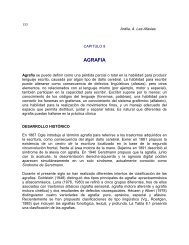the PDF of her book - National Aphasia Association
the PDF of her book - National Aphasia Association
the PDF of her book - National Aphasia Association
You also want an ePaper? Increase the reach of your titles
YUMPU automatically turns print PDFs into web optimized ePapers that Google loves.
Tales from <strong>the</strong> O<strong>the</strong>r Side <strong>of</strong> Language 41<br />
complex to me, so I choose two or three blossoms and immerse my eyes in<br />
<strong>the</strong> individual qualities <strong>of</strong> each. The bent stem <strong>of</strong> one leans over, casually<br />
drifts in space. The fluffy edge <strong>of</strong> a purple aster is disfigured with yellow,<br />
secreting its mortality inside its beauty.<br />
I pare <strong>the</strong> overabundance <strong>of</strong> leaves to a few that urge brightly or quiver<br />
around <strong>the</strong>mselves, no vase. My flowers are suspended across <strong>the</strong> page.<br />
I take a break and walk around <strong>the</strong> room to look at everyone else’s<br />
work. I see enormous differences. One woman draws <strong>her</strong> blossoms in a long<br />
row growing out <strong>of</strong> <strong>the</strong> bottom <strong>of</strong> <strong>the</strong> paper. I find it very odd and childish.<br />
But <strong>the</strong> judgment recedes, and I see <strong>the</strong> pleasure in <strong>her</strong> radical arrangement;<br />
<strong>her</strong> use <strong>of</strong> <strong>the</strong> colored pencils is sharp and bold. I am more tentative. I learn<br />
from <strong>her</strong>.<br />
The teac<strong>her</strong> hangs our work on <strong>the</strong> wall for <strong>the</strong> last twenty minutes<br />
<strong>of</strong> each class. She doesn’t critique so much as appreciate. She describes <strong>the</strong><br />
special way each <strong>of</strong> us looked at <strong>the</strong> same vase <strong>of</strong> flowers and <strong>the</strong>n set a unique<br />
vision onto <strong>the</strong> paper. She is supportive <strong>of</strong> what we see.<br />
This is a pr<strong>of</strong>ound lesson for me, this intimate act <strong>of</strong> private seeing. No<br />
“right” way, only <strong>the</strong> personal way.<br />
My seeing is changing. A new kind <strong>of</strong> candor emerging.<br />
Everyw<strong>her</strong>e I listen to music—in <strong>the</strong> streets, on <strong>the</strong> subway, and<br />
especially between patients. I plug a baroque chamber sound-scape into<br />
my headphones, and <strong>the</strong> outside chaotic sounds and energies <strong>of</strong> <strong>the</strong> city<br />
disengage from my body. My brain floats free in Hayden or Corelli. The<br />
sound is intimate, resonant against <strong>the</strong> battered walls <strong>of</strong> my aching brain. It<br />
smoo<strong>the</strong>s on like a salve, and my verbal brain quiets in <strong>the</strong> surround—as if<br />
<strong>the</strong> Dalai Lama is chanting.<br />
I have believed that words, good sturdy words, were core to my<br />
existence. To articulate thought well is to be alive, to be seen in <strong>the</strong> world.<br />
I am learning o<strong>the</strong>r ways <strong>of</strong> being. From drawing I ease into watercolor<br />
painting, tiny brushes and delicate forms, a cluster <strong>of</strong> daisies with pinks and



